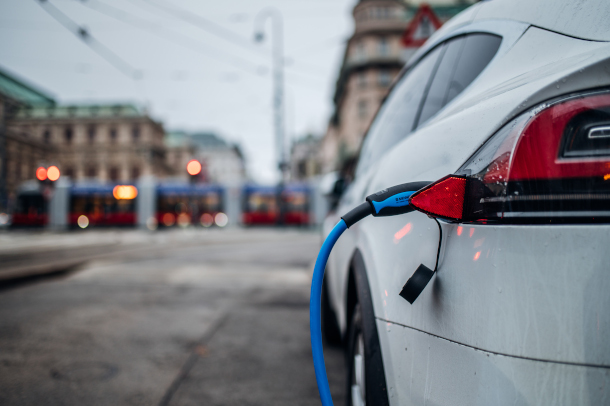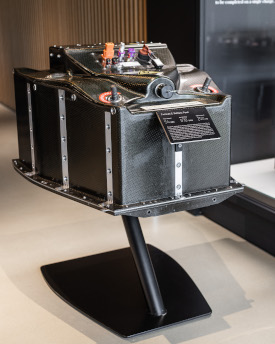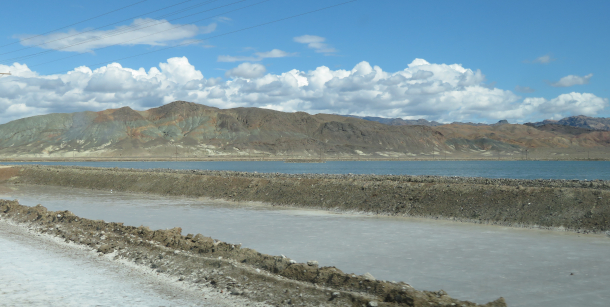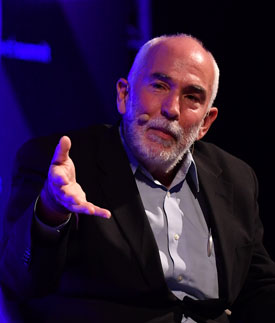Revving Up U.S. EV Manufacturing
Air Date: Week of April 14, 2023

The Biden Administration has set a goal for 50% of vehicles sold in 2030 to be zero-emissions vehicles. (Photo: Ivan Radic, Flickr CC BY 2.0)
The government offers a $7,500 tax credit to new car buyers to help meet a goal that 50% of all new vehicles sold in the U.S. should be electric by 2030. But to qualify, cars must now meet a new set of requirements. Auto reporter Jim Motavalli joins Host Jenni Doering to talk about how EV manufacturers are responding.
Transcript
DOERING: President Biden has set an ambitious goal that 50% of all new vehicles sold in the US should be electric by the year 2030. But that goal might be tough to meet as a recent poll says just 4 in 10 Americans are somewhat likely to buy an electric vehicle as their next car. To encourage buyers and make EVs more affordable, the federal government offers a $7,500 tax credit but only for vehicles that meet certain standards. And now those standards are getting a lot tighter. 40 percent of the minerals must come from the United States or a country that has a free trade agreement with the US and final assembly must take place in North America. For more on gearing up for electric vehicles I’m joined now by Jim Motavalli, who writes about green transportation for Autoweek and Barrons. Welcome back to Living on Earth, Jim!
MOTAVALLI: It's great to be on.
DOERING: So what are some of these restrictions that determine whether or not an electric vehicle is actually qualified for the $7,500 federal tax credit?
MOTAVALLI: Well, what we had under the old rules, any automaker that manufactured an EV could pretty much qualify. So the only thing that got you out of qualifying was if you produced more than 200,000 cars. And this is why both General Motors and Tesla no longer qualified for the tax credit under the old rules. So cars made in Germany or Korea or even China could qualify for it. And if you're big on saying that we should only be subsidizing American made products, or vehicles with a lot of U.S. content, then that kind of rankles. So the new rules very much look at where the car is what they call final assembled. And whether that's in North America or not. So there are multiple things you have to do to qualify, and the consumer has to do a bunch of things. Like, you can't have income above a certain limit. And the car also has to be at certain price points for a car, it's not over $55,000. And for an SUV or a truck, it's $80,000. I think the most important point here, and you have to give Joe Manchin, the senator from West Virginia credit for this, it has spurred enormous investment in the United States in the form of both car plants and battery plants, and also the search for and mining of minerals and their recycling. So in terms of investment in America, that law has had a major positive effect. But it has also caused a lot of trade problems. And the companies that are not eligible are squawking about it quite a bit to foreign diplomats, American diplomats, and they want a piece of that pie.

An electric battery pack used in Formula E racing, a kind of electric-only motorsport. One of the new EV tax credit qualifications concerns how much of the vehicle’s battery components have been manufactured or assembled in North America. (Photo: Automotive Rhythms, Flickr, CC BY-NC-ND 2.0)
DOERING: So what manufacturers are going to be left out of this tax credit once these restrictions take place?
MOTAVALLI: Well, it's still in flux. The biggest pain point right now is that the Hyundai Kia, they're made in Korea, they're not made in the United States. But the company is prepared to do $10 billion worth of investments in the United States. And the car that they just announced at the New York Auto Show, the EV9 is going to be built in Georgia. So all this is changing. We do have a list of the manufacturers that definitely qualify. And I would say that at this point, most of them do. I was able to find it online. In fact, the IRS has a list of them. So you know Audi, BMW, Ford, and most of the things that GM makes, all the Nissan LEAFs, pretty much everything made by Tesla. Like I said, it's in flux, you know, they're still working on it. They're gonna do everything they can to make sure that their vehicles are eligible, including spending billions of dollars in the US to build battery and car plants, which is what we're seeing now.
DOERING: So to what extent are these new restrictions going to create some winners and some losers in the EV market?

Silver Peak Lithium Mine in Nevada is one of few lithium mines in the United States. In 2020, Australia, China, and Latin America accounted for around 98% of all lithium production. (Photo: Ken Lund, Flickr, CC BY-SA 2.0)
MOTAVALLI: Well, I think the winner is going to be the consumer, really. I think that the companies that don't comply, like say, don't currently comply like Hyundai Kia, they're going to comply by building factories and battery capacity in the United States. That's already true of Kia Hyundai, so if their 2023 model doesn't qualify, their 2024 will probably get under the wire. So then the consumer gets a cheaper vehicle, both because the manufacturers are lowering their price to meet the limits. And because they qualify for the income tax credit. So it's kind of a win-win for the consumer. It's a lot of pain for the automakers, because their tendency is to build plants where it's cheapest to build, you know, it's cheaper to build cars in China, or Korea. But if you look at say lithium sourcing for the United States, it's the critical ingredient in electric vehicle batteries, pretty much all of them. We had practically no lithium mining or processing in the United States. Until now. Now we have a whole bunch of lithium mines opening as well as lithium processing which was almost entirely in China until now.
DOERING: It seems like changing up the structure of a global supply chain and getting the permits for new lithium mines, getting the permitting for new EV manufacturing plants, those things always seem to take a long time. Years. But how fast do you think these manufacturers will actually be able to meet these standards?
MOTAVALLI: Well, that's a good point you're making. Yes, it takes a very long time to qualify a new lithium or cobalt mine. But right now something, 70% of all the cobalt that we use in electric vehicle batteries comes from the Democratic Republic of the Congo, which has major child labor and working condition issues. So having a source of these things in the US or in North America generally is a very good thing. So permitting the new mines takes a long time, reclaiming those materials from used EV batteries, that takes less time. And another thing that I've just done a big story about is a number of companies opening that are doing recycling of these important minerals, especially including lithium, but also cobalt, nickel, copper, all those things that are in the batteries.
DOERING: Yeah. How hard is it to recycle those rare earth minerals from these batteries?
MOTAVALLI: It's not that hard. They have a process for doing it. One of the big companies is Redwood, which is headed by the former Chief Technology Officer at Tesla, JB Straubel, and they are doing you know, I think it's over 90% of the minerals in the battery.

Jim Motavalli is a freelance environmental journalist and blogger for Autoweek and Barrons (Photo: Seb Daly, Web Summit, Wikimedia Commons, CC BY 2.0)
DOERING: So the Biden administration has actually just unveiled a new timeline, a new track for much stricter limits on vehicle emissions. What do you see in terms of the changes that are coming for the electric vehicle and overall auto market in the US?
MOTAVALLI: Well, the standards are very tough. Biden basically set a very high bar, he really wants the auto industry to pivot to electrification. The automakers say they're totally congruent with that, they've all said they're pivoting to electrification anyway. But they hate regulation. So they don't like being told they have to do it on a certain timetable. But you know, climate change is extremely ruthless. The IPCC, which is the international climate change body just put out a report that is very dire in terms of the effects of climate change and global warming. So there is a certain urgency to this. But I think we're gonna see a lot of automaker lobbying against the rules to try to water them down during the public comment period, which I think is like 30 to 45 days, something like that. And you're also going to see green groups, environmental groups, trying to make sure that they don't water them down. But you know, it's going to be hard for automakers to meet this as, right now, electric vehicle sales are about 5.8% of the market. And we're looking to, you know, get it just a few years, over half of all the vehicles sold. So, yes, it's a big ramp up. And it's asking a lot of consumers and automakers.
DOERING: Jim Motavalli is a blogger with Barrons and AutoWeek. Jim, thanks so much for taking the time with us today.
MOTAVALLI: Great, always fun to be on.
Links
The New York Times | “New Rules Will Make Many Electric Cars Ineligible for Tax Credits”
Barrons | “Bigger is Better for EVs at the New York International Auto Show”
Read more about which EVs qualify for the tax credit at the IRS website
Living on Earth wants to hear from you!
Living on Earth
62 Calef Highway, Suite 212
Lee, NH 03861
Telephone: 617-287-4121
E-mail: comments@loe.org
Newsletter [Click here]
Donate to Living on Earth!
Living on Earth is an independent media program and relies entirely on contributions from listeners and institutions supporting public service. Please donate now to preserve an independent environmental voice.
NewsletterLiving on Earth offers a weekly delivery of the show's rundown to your mailbox. Sign up for our newsletter today!
 Sailors For The Sea: Be the change you want to sea.
Sailors For The Sea: Be the change you want to sea.
 The Grantham Foundation for the Protection of the Environment: Committed to protecting and improving the health of the global environment.
The Grantham Foundation for the Protection of the Environment: Committed to protecting and improving the health of the global environment.
 Contribute to Living on Earth and receive, as our gift to you, an archival print of one of Mark Seth Lender's extraordinary wildlife photographs. Follow the link to see Mark's current collection of photographs.
Contribute to Living on Earth and receive, as our gift to you, an archival print of one of Mark Seth Lender's extraordinary wildlife photographs. Follow the link to see Mark's current collection of photographs.
 Buy a signed copy of Mark Seth Lender's book Smeagull the Seagull & support Living on Earth
Buy a signed copy of Mark Seth Lender's book Smeagull the Seagull & support Living on Earth

